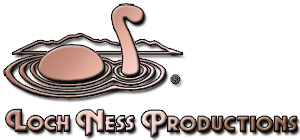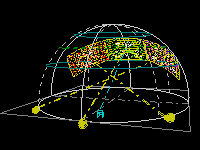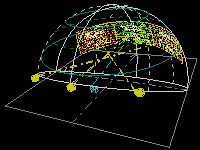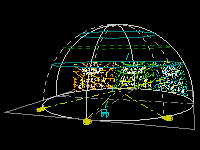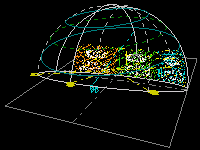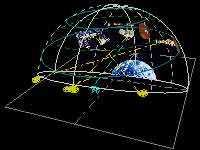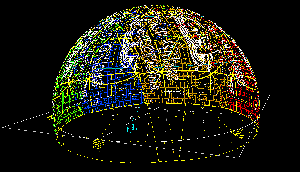| In the production studio: Computer with CD-ROM drive Image processing software Output device |
| In the theater 1. At least three dissolve-pair slide projectors in L-C-R array |
| 2. Dissolving horizon panorama and/or all-sky projector system |
| 3. All-sky projector system |
| 4. Planetarium star projector |
| Recommended: Zoom-slew Laser graphics projector |
| NOT used: Video |
Light Years From Andromeda Equipment Requirements
With more than 127 images to show, Light Years From Andromeda is not the most visually complex show we offer, but it still requires a well-equipped planetarium theater to present. We've provided this page to help you determine if your planetarium has the necessary equipment to present Light Years From Andromeda.
The show soundtrack is recorded on CD, so you'll need a CD player to play the disc, even if it's just to copy the audio to another medium, such as multi-track tape or hard drive.
The show's still images are recorded on data CD, so you'll need the resources (computer, image processing software, output devices) to transform the digital images into whatever form your theater uses to project. For classic (slide-projector-based) planetaria, that will mean making 35mm slides.
1. At least three dissolve-pair slide projectors in Left-Center-Right array
This is a screen format familiar to long-time Loch Ness Productions customers.
Many of the scenes in our shows are illustrated with three images, which are introduced in sequential order: Left, then Center, then Right. After all three are up, they often "wipe" off in the same order.
In this show, the left and right screens don't necessarily have to be dissolvers, but for timing, there are instances in which dissolve pairs may come in handy.
The Big Bang sequence is a 6-image lap-dissolve, as is the Earth with a light beam arrowing around in.
We say "at least three" dissolve screens, but the more, the merrier. There are several points in the show where you may wish to make a whole-dome montage of images, such as the HST images toward the end.
2. Horizon panorama and/or all-sky projector system
There are 9 multi-panel images in the show — which, using 20th-century terms, can be translated as horizon chords and panoramas. In the digital age, what may be a 3-panel pan in one theater may be a 2- or 4-panel pan in another, or a pan can be remapped to an all-sky. Nonetheless, you'll need that calibrated set of projectors which project on the horizon, commonly known as a panorama system.
As you know, individual slide frames are in a 3:2 ratio. Most of the multi-panel images in the show are in a 9:2 format ratio — what might otherwise be called "3-panel partial pans". These are intended to span approximately 90 degrees on the horizon.
All this is in addition to the dissolvers, which project up in the sky, of course. There are times you'll use both together, such as when a chord is on the horizon, and spacecraft on orbit above it.
Actually, using dedicated projector with an anamorphic lens to stretch the chord images works even better.
3. All-sky projector system
There is one full-dome all-sky scenes, utilized twice in the show. We're in intergalactic space, equidistant between Andromeda and the Milky Way.
There are 3 stained glass church windows designed for use in an all-sky, but in every other projector, not a seamless scene.
4. Planetarium star projector
Light Years From Andromeda uses the planetarium star projector primarily for its starfield, when depicting space scenes. When we're not depicting space scenes — quite often, actually — we recommend fading stars out. The starfield shouldn't be generic wallpaper throughout the show.
The Andromeda Galaxy, needs to be pointed out in the sky on cue, as does Sirius, Betelgeuse and Rigel.
Recommended: Zoom-slew, Laser graphics projector
While non-moving slides can illustrate the scenes, the show will benefit from having spacecraft flying by Mars, Hubble drifting slowly in Earth orbit, etc.
What about a light-beam effect? In reality, you wouldn't see an individual light beam, of course, but this is illustration we're talking about. If you have a whole-dome graphics or laser projector, animated line segments would be an obvious choice to use. Some people have strung fiber-optic light ropes to good effect. Or, you could let people use their imaginations.
NOT used: Video
We use no moving video with the show, intentionally. This is a program designed for the pacing of still imagery. The visual style of the show is non-dynamic slides. To have inserted just one or two video clips would have been very jarring and out-of-context with the remainder of the show. In other words, why would there be only one or two scenes that feature full motion animation, when the rest of the show doesn't have any?
